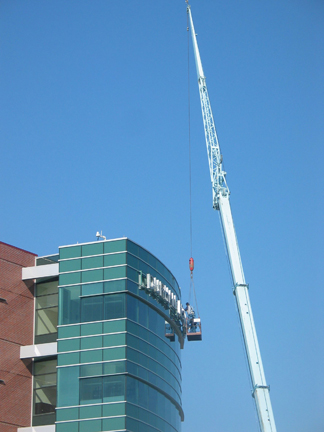 |
 |
Nor is it done with a flick of the wrist.
Instead, it takes patience, perfect weather conditions, a 150-foot crane and a non-acrophobic mind to service the Durham Research Center signs that tower over Saddle Creek Road.
Workers with Omaha Neon spent Wednesday and Thursday 120 feet in the air servicing the neon glass tubing in the exterior signs on the east and north face of the building. The south face was done earlier this year with a smaller crane.
“As long as a component doesn’t break down prematurely, it should be five to seven years before we have to do this again,” said Nick Combs, director of maintenance and utilities for UNMC.
Each letter — approximately 36 inches tall and 5 inches deep – is illuminated with one or more pieces of custom-made neon tubing inside of it. And each tube is literally custom-bent to the shape of the letter, Combs said. The “M,” for example, has more surface area so it requires three pieces of custom bent neon tubing. Each of the letters also is a fully independent sign with its own light source and power supply. That keeps the sign lit even if one letter flickers or goes dark.
Omaha Neon workers did preventive maintenance on each letter, Combs said, but only had to replace the power source in one — the “D” on the building’s east side.
Interestingly enough, the signage on the south side of The Lied Transplant Center hasn’t been serviced since its installation in 1998, Combs said. “It typically does have a pretty good life, but we’ll likely service that sometime this summer,” he said.
Weather will largely influence when that occurs, he said. “Rain and wind are a killer for this so it’s been difficult to find a window when its been both dry with no wind,” he said. “High humidity also would preclude us from doing the work.” Combs said the voltage in the neon is extremely high – 3,500 to 3,800 volts – as compared to 120 volts in an office.